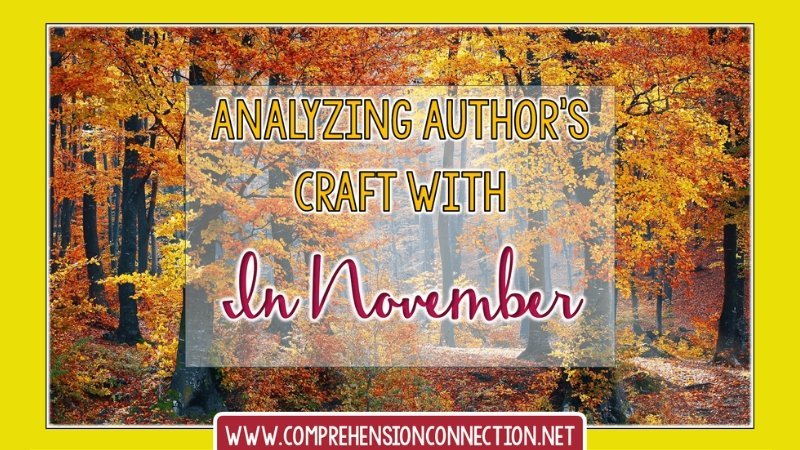
Author’s craft is a really important skill. Some authors have a way of using words to show versus tell about a topic. When you find a book filled with description, you know you have a great mentor text for author’s craft. Here in Virginia, signs of fall are all around, and Cynthia Rylant describes it so eloquently in her book, In November. Here’s one example of author’s craft. Can you picture this?
In November, the trees are standing all sticks and bones. Without their leaves, how lovely they are, spreading their arms like dancers. They know it is time to be still.
Cynthia Rylant
In November , a Mentor Text for author’s craft
Wow! Isn’t that poetic? It’s because of this poetic language that I chose to study author’s craft with this mentor text, and if you explore Cynthia Rylant’s work further, you’ll find many of her books to be similar in this way.

Analyzing author’s craft is a challenging skill for struggling readers, and unfortunately, it’s not the easiest to find resources for either. Like you, I went to my go-to places for ideas…Pinterest and Teachers Pay Teachers, and although I found some options, the options were not plentiful. I hope to share a few ideas you might try to help your struggling readers struggle less and use thinking more. After all, I see analysis is at the top of Bloom’s, but with strategy work, all of your students can figure it out through discussion and deeper thinking.
Introducing Author’s Craft
So, the first step is to break down the skill into strategy steps. The way to do this is to anchor thinking with something that will hook students in. Once hooked, then walk your students through the thinking process using think aloud. By using this approach, you scaffold your students and can gradually release that task to them.
One of my favorite schema building activities is to get students talking and brainstorming. Upper elementary students are naturally social, so use that to your benefit. You might try bringing in a pumpkin (or gourd) and have the students brainstorm describing words for it. You might use an ABC Brainstorm form to have your students come up with words related to fall. Regardless of what you choose, you want to get your students thinking (and talking) like a writer with as much description as possible.
Begin with an Anchor Chart:
Once you’ve set the purpose and have students thinking as writers, you might share an anchor chart such as these two superbly done freebies from Hello Literacy and Erintegration to explain what we think about when we’re analyzing the author’s craft. My suggestion would be to include one of these handouts in your interactive notebooks and have your students using close reading strategies to mark the most important points.
Modeling author’s craft with In November:
Once your students know what to look for in the text, it’s time to work *with* the text. This is best done in pairs to allow students to discuss their observations. As students read the text (or as the teacher reads the text aloud), students stop and jot their thinking.

I chose four features with this lesson-descriptive text (record figurative language and sentences that describe well), imagery (what students imagine as they read), mood/tone (how the text makes them feel), and author’s viewpoint (how the author feels about this time of year). Student responses will vary somewhat, and I would recommend group discussion after the children have had an opportunity to record their thinking with their partner.
Modeling the Lesson
After this post was shared, I did a Facebook Live session explaining the lesson. You can check that out below.
Freebie Download
The freebie below includes teaching ideas. I suggest printing the anchor charts linked above too.
Studying author’s craft is best done across multiple texts, and Cynthia Rylant has several books in particular that I’d recommend. Not all of her books include the deep description you find in In November. I would use Scarecrow, Silver Packages, long night moon, The Bird House, The Dreamer, All I See, Snow, When I was Young in the Mountains, The Relatives Came, and although simple, All in a Day. Teachers might pull these books, have groups of students work as a team to analyze them, and record thinking on chart paper to share with the others. Assigning each student a “look for” ensures accountability with the group’s work.
Purchase the Author Study:
If you’d like to extend your study of Cynthia Rylant’s work for the middle/upper elementary grades, you can view my Cynthia Rylant Author Study that includes deeper studies of In November as well as The Relatives Came, When I was Young in the Mountain, Scarecrow, All I See, The Great Gracie Chase, Christmas in the Country, Silver Packages, All in a Day and Snow (10 units with 350+ pages).
This bundle includes both Digital with Google Slides TM and PDF options, so you can use black and white pages with small groups or the full color digital version for modeling on your smartboard or on one-to-one devices for stations. I know I love both options for the flexibility. This bundle sells for $32 (price of 6 units and a savings of $20). You can also purchase the full In November for $5.00 [HERE]
-
Sale Product on saleCynthia Rylant Fall Literacy Book Study Bundle with Activities for 10 Titles
$51.92Original price was: $51.92.$27.00Current price is: $27.00.
Pinterest Board for Cynthia Rylant Activities
Related Posts:
For other teaching ideas to go with Cynthia Rylant’s books, check out other posts on my site.
- Teaching with Cynthia Rylant’s Books as Mentor Texts
- Scarecrow Resources That Will Simplify Your Teaching Life
- Using the Six Traits for Writing Instruction: Mentor Texts for Teaching Voice
Teaching author’s craft isn’t easy, but I hope these ideas provide you with an easy to use resource for your lesson.















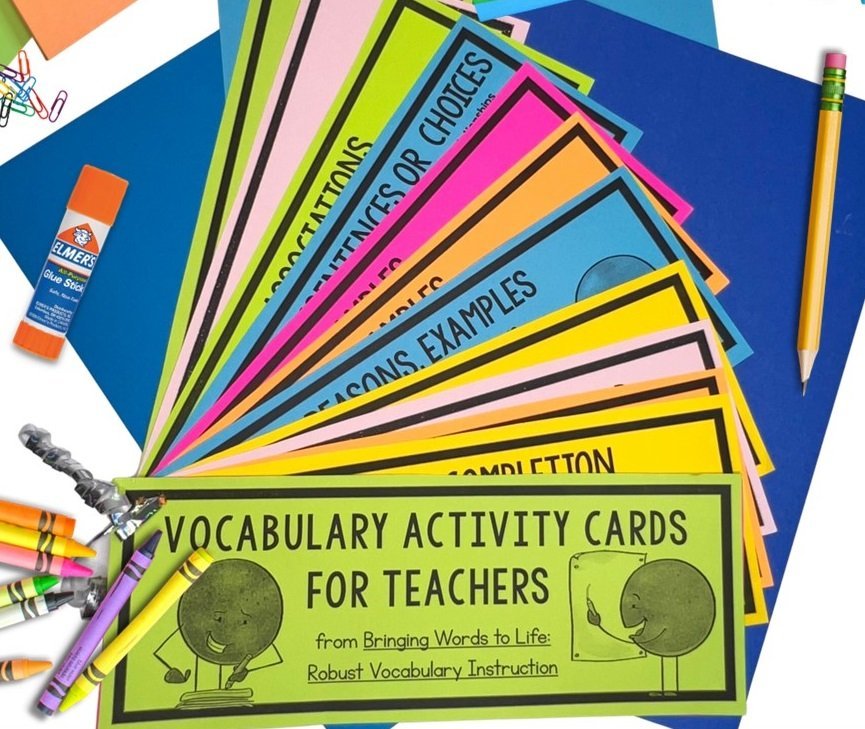
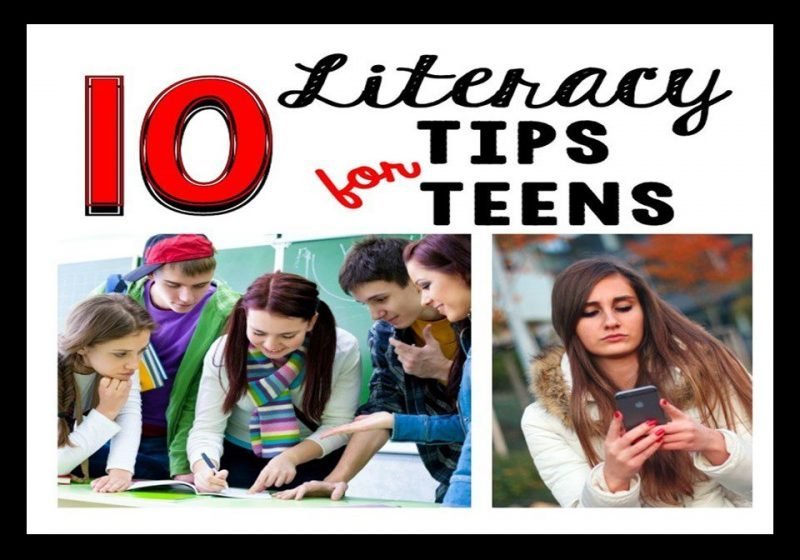
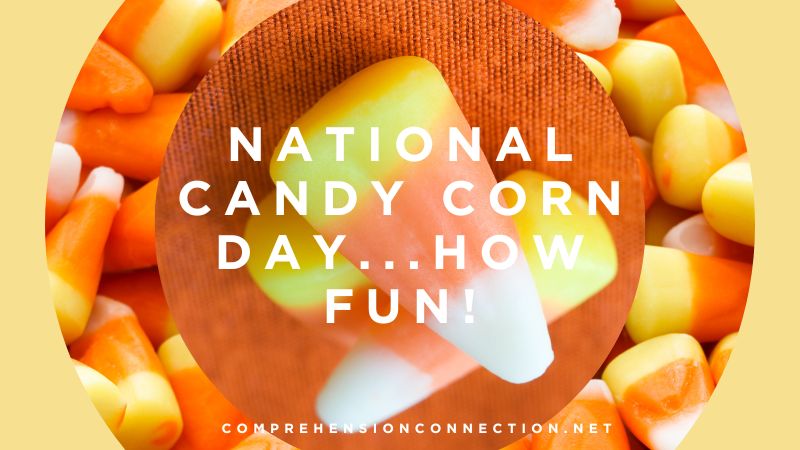

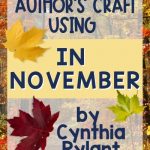





4 Responses
Thank you, Carla, for sharing that beautifully written text. I will have to add that to my collection. I love Cynthia Rylant's books for teaching a variety of skills. It's funny, I went to an Empowering Writers conference earlier in the week, and the instructor mentioned the book, "Scarecrow" as being a great one to teach elaborative details. I'm going to have to pick that one up as well. Thank you for the tips and freebies!
I have a unit in my store for Scarecrow with exactly that! My students wrote the best stories. Yesterday's post has the link to it if you page down, or all of my Cynthia Rylant units are included in the Author Study above. It's a growing bundle, and I plan to add in units for the other descriptive texts I mentioned. I'm adding a link to my In November full unit too now. Thanks for dropping by. Some of the links are dead at the moment, but we're working to correct them.
I LOVE Cynthia Rylant. After reading your post yesterday, I pulled out all my Cynthia Rylant books so I can plan for this study. Such a great resource. I'm excited about all the books this hop shared! 🙂 Happy Fall Carla!
Those freebies from Hello Literacy look great. All in a Day is not a book that I've ever heard of but we do a lot with the author's message in first and second so it looks perfect for that based on your descriptions.
Jessica
Literacy Spark